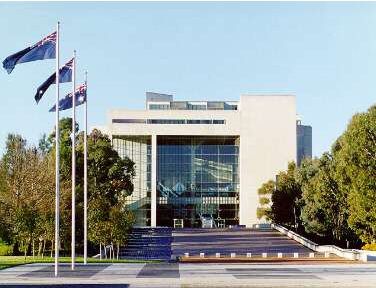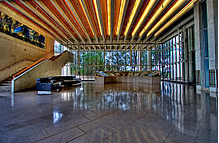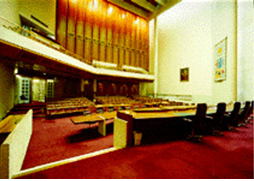Introduction
The Australian High Court is a national monument with historic, judicial and architectural significance to both the people of Australia and scholars. Its architectural design is unique to its time of development and is especially significant as it seeks to portray the important role the judiciary plays in the lives of Australians.
This discussion will especially focus on the importance of the building’s design as well as the use of construction materials within the confines of architecture to bring forth the desired judicial posture of the Australian judiciary.
Precisely, there will be a brief look at the history of the building and as well as the location and site selection. Importantly, the discussion will focus on the Brutalist architectural style that was used to build the structure the rationale behind adoption of this style and the intricate use of materials to produce an architectural finish that reflects the overall Australian judicial aspirations.
There will be an overt emphasis on concrete which is the main building material in the building and an analysis on how concrete is used to bring out the Brutalist style of architecture. Part of the information used in this discussion was provided by an Australian High Court clerk who answered a list of pre determined questions that were asked to him through a phone interview.

High Court of Australia building
History
The history of the High Court building dates back to 1950 when Prime Minister of Australia Robert Menzies pushed through plans develop Canberra to a national city where government offices are to be located (MacMahon 2001, p. 147).
In 1972, the government through the NCDC conducted an international architectural completion for the building’s design. Out of a total of 158 designs that the NCDC received, only six made it to the final stage with a winner- Edwards Madigan Torzillo and Briggs Pty Ltd- announced in October 1973 by the Premier Whitlam.
The NCDC advertised for contractors for construction of the building with the tender awarded to PDC Constructions Pty Ltd. The Prime Minister unveiled the foundation plague in 1975 and the project was completed in April 1980. Its official opening took place on May 26th the same year.
Site and Location
The eventual location of the Australian High Court is a result of the original plans by Walter Burley Griffin’s 1911 designs that envisioned a new national capital with a section specifically meant for a group government buildings that astride the Land Axis at the lake side Water Gate.
The designers of the building were fronting for a large building that will effectively reflect the constitutional status of the High Court instead of its actual work related needs.
The Australian government decided in 1968 its decision to transfer the principle seat of the High Court to Canberra whose building was to be located next to the Parliamentary Triangle and the National Library Service. According to Edquist & Grierson (2008, p. 93), site lines of the Australian High Court were carefully designed to ensure the building will be seen as a separate and independent entity from the adjacent buildings.
Construction of the court did not encounter many challenges. There were some delays on the part of the legislature in setting up the High Court of the country, initially, long before the government decided to move the national capital to Canberra.
Once the site was decided, the NCDC swiftly moved to map the ground and invite architects to come up with the design that would suit the location and ensure the building stands out while blending with the rest like the national library.
Architecture of the building
A critical look at the High Court Building of Australia heavily depends on the correct and accurate examination of the architectural principles behind it. According to Blake (1973, p. 78), the architecture of a building makes it a unique symbol that reflects its use, location and the culture of the people that use it.
The High Court of Australia is a classic example that exhibits a rare Canberra example of Brutalist Architectural style that helps bring out the social and symbolic significance of the building as the focus of judicial practice in Australia.
Dovey (2010, p. 123) describes the Australian High Court building as belonging to the National Gallery Precinct whose structures explicitly express Brutalist architectural style that was common in the 1920 and that characteristically showed strong bold shapes. He adds that the style of the building contributes to the monumental presence among the buildings of the Australian National Gallery precinct.
According to Taylor (1986, p. 154), Brutalism architecture has its origins from the modernist architectural movement that was popular in the decades spanning 1950’s to 1970’s in Europe. Swiss architect Le Corbusier and German designer Ludwig Mies van der Rohe are credited to have inspired the rise of Brutalist architectural designs that mainly used raw concrete as the main building material.
Aggressive largeness and muscular characteristics defined Brutalist structures with the style aiming to be honest with structural material, concrete walls and columns. Additionally, Brutalist style structures were honest with beams and lift shafts.
Blake,(1973, p. 148) reinforces the honesty idea by asserting that Brutalism’s idealized qualities developed over time with special emphasis on honest presentation of structure, materials, service and form of structures. Also, it favored an honest expression of the functional elements of space and the relationships between them.
Among the special characteristics of Brutalism that practitioners like British architects Alison and Peter Smithson emphasize on are the moral and ethical imperatives. Besides, the architects argue that Brutalism falls within the aesthetic frame of reference.
Overseas development in architecture helped the development of Brutalist architectural style in Australia in the 1950’s and 1970’s with its debut in the country through Late Twentieth Century Sydney Regional Style.
Brutalist characteristics of architecture are evident in the High Court building especially through internal support columns, patterns of supporting beams and other externals elements of architecture
It is important to note that the Brutalist architectural style was unique at the time and the High Court of Australia building reflects the uniqueness through the materials used.
In later sections of this discussion, there will be focus on the components of the building and the materials that were used to produce this symbolic structure that is so monumental to the Australian Judiciary. To help in understanding the architectural intent of the building, the discussion will examine the design and concept behind the Australian High Court building.
Design and Concept Rationale
The Brutalist style of architecture that built the Australian High Court building is renowned for producing large and strong looking structures. However, the EMTB design that the architects adopted carefully fused with Brutalism to give rise to a building that emphasizes a feeling of spaciousness within the building.
More importantly is the exposure of the main materials used in the building namely concrete, glass and wood chiefly to its nobility as well as enhance the inclusion of visitors in the workings of the building.
The building’s form expresses the symbolic nature of the work that takes place in it while rendering a feeling of nationality to the adjacent public areas. Furthermore the building presents smooth transition areas that accord any visitor a feeling of smooth transition from the large and compact outside to the judicial character of the rooms used by judicial officers.
Description of building and materials used and how they contributed to architecture
To further understand the use of materials in the building a detailed look at the construction components will come in handy. Generally, poured in-situ makes up the main construction material with reinforced white concrete that collectively gives the High Court building a monolithic structure.
According to Dovey (2010, p. 130), Brutalist buildings like the Australian high court normally have striking repetitive angular geometries that exaggerate the use of concrete with pronounced revelation of the wooden texture of thanks to in-situ casting.
Dovey (2010, p. 130), further says that despite its dominance, concrete is not the only material that helps bring out the Brutalist architectural style in buildings. Rough blocky appearances come in handy in bringing out the Brutalist quality with a special emphasis the structural materials and services to the exterior just like the High Court building has done.
The building mainly uses tubular steel structural back-ups to support huge areas of glazing that don the east and vast south walls. This is carefully detailed especially to make use of natural light in the building.
Internally, the floors make use of Aurisina stone, Pirelli and rubber carpet giving the place a uniquely rich and restrained finish. Plywood paneling, timber battened, concrete and plaster make up the wall and floor finishes.
The High Court building of Australia spans 11 floors, approximately 41 meters above the ground. With a measure of slightly above 18500 meters, the building’s internal floor lies in the middle of a hectare of Aurisina Stone and tile that form part of both the Ceremonial Ramp and the forecourt area.
The building boasts chambers for justices, administrative offices, a restaurant and a library. Closer observation of building’s design will expose the Late Twentieth Century Brutalistic architectural style that expertly combines aesthetic value and honesty expression.
The building spots a cubic shape from the outside with various elements receding or standing out from the main form especially on elevations in the west and north.
The building has a glass rising that rises almost the full length of the building with support from steel trusses on the southern wall complimented by another major glass wall on the wall to the north.
Opposite the National Gallery is s wall with huge concrete and glass areas which makes it look normal and commensurate with Brutalistic style. Besides, there are a series of columns on the same wall which forms a tall undercroft.
The walls, both internal and external which make a distinct component of the building don concrete reinforced in-situ resulting into smooth and/or bush hammered finishes. In the inside, other walls are finished with timber or plaster paneling.
The woods used on these walls include coach wood, Blackbean, Red tulipoak, Red Cedar and Blackwood. On the western side of the ceremonial ramp is a South Australian Speckled Granite. Concrete is normally left unfinished after pouring effectively leaving it exposed. The imprint of wood and/or plywood comes in handy as it is used for the final surface finishing (Taylor 1986, p. 160).
One of the dominant features of the building is the Public Hall, a 24 meter high entry with ramps foyer with ramps and stairs leaving the level of entry to the hall. The hall’s ceiling is made of waffle and gets support from two large concrete pillars centrally located in the building.

Entry hall of the High Court Building
Materials, Architectural Intent and aesthetic value
The High Court building is full of qualities that leave no doubt about its creative achievement concerning the architectural style and the overall intention of the designers. MacMahon (2001, p. 67) says that the original intention of the High Court development was to produce a structure that dominates its place of location in terms of height, scale and monumentality.
After finishing, the designers and judiciary officials envisioned a white or off-white building whose design was closely related to that of the National gallery. The use of concrete and in-situ provided the perfect materials that Brutalist style of architecture needed to produce a building that fits the above description with a hammered texture.
It is important to note that there will be a subtle emphasis on the use of concrete that many building experts deem to be the main material behind Brutralist architectural style.
A careful look at the High Court building displays dominant features that characteristic of the Late Twentieth Century Brutalistic style that is unofficially Australia’s version of Brutalist architecture.
A reinforced concrete structure, off-form concrete, boldly composed strong shapes, diagnonal elements that contrast with horizontals and verticals and expansive areas of blank wall are some of the Brutalist properties that characterize the High Court building.
The ethic which is very basic to the Brutalist architectural style is very evident through the honest statements of its architecture as displayed by its design. In this regard, honest expression of functional spaces as well as the interrelationship between structure, materials and form has put the building top among its timeless peers that spot both style and fashion.
Furthermore, the large areas of bush-hammered off white concrete supported by steel structures and the outstanding character of both the exterior and interior display exceptional creativity. Besides, craftsmanship is at display especially through concrete and timber finishes that are present in different rooms of the building.
Besides the monumental, tough and imposing look that building offers through the concrete dominated structure, it also offers a rich sensory experience to its visitors owing to its abrasive look thanks to the bush hammered concrete walls and the contrasting use of materials including concrete and warm timber.
Generally, the building offers many locations of viewpoints which offer visitors a number of viewpoints. Externally, the Ceremonial Ramp and the Cascade water feature stand out and offer a magnificent view especially from the southwest entry.
The public hall compliments the monumental scale of the building with exceptional structural qualities that characterize the roof system with special use of geometrical forms as well as outstanding columns.
Quality Details
The quality of architectural work at the High Court building is has never been in doubt. The designers put a lot of effort in coming up with near perfect designs on the different parts that make up the building. According to Dovey (2010, p. 135), the quality of a structure such as the high court can be analyzed through various angles.
A look at whether the materials used and specific components of the building are serving their purpose effectively can easily help experts to determine the quality of architectural work put into a project.
Among the many components of the court building is the public hall where use of concrete, wood and other finishes help give a near perfect finish highlighting the quality of work that has been put into the project.
Design and construction of the public hall of the High Court provides some of the most interesting details that make the building a marvel. The hall has a 24 meter high ceiling that with support from large concrete pillars. The floor finishes comprise of the imported Italian marble Aurisina. Besides the public hall, the building has three court rooms in which some of the most important judicial business is conducted.
They too are some of the impeccable details that contribute to the quality of the work done on the High Court building. The number one courtroom is the most important room in the building where judicial decisions are made by justices of the court sit.
With a Blackwood panel ceiling reaching 17.5 meters the room spots two levels that serve as public gallery. Red Tulip Oak graces the paneling of the wall and also is the main material for the furniture in the gallery. Like in the public hall, Aurisina graces the courtroom’s floor as well as the bench face.
All the court rooms’ doors have a special design with bronze and laminated plate glass characterizing the door to court room one. Court room 2 has similar design fittings as court room one only that it is smaller and the ceiling is graced with painted moulded plywood. Court room three features furnishings from coachwood timber while its ceiling is mainly made of glass purposely for natural lighting.

Court Room 1
Conclusion
The Australian High Court building is unique in its own way. From the above discussion and illustrations above, it is clear that the building’s design has used concrete and wood with limited use Aurisina marble on the floors. Also, there is significant use of glass on the wall and ceilings of the different rooms within the building.
Throughout the description, Brutalist architectural style comes out distinctly especially with the use of concrete. It is apparent that the High Court is an imposing structure that symbolizes authority protection of the country’s constitution and citizen’s liberties.
It is important to note there are numerous other types of materials used in the construction of the building. However, concrete, wood, marble and glass are the most dominant. Through the Brutalist architectural style employs the use of these materials it will not be correct to assume that they were the only ones used.
Through renovation, there have been various improvements and modifications to the building’s form. However, the improvements have been minimal and the original style and architectural intention of the building remain intact.
Reference List
Blake, P 1973, Architecture for the new world: the work of Harry Seidler, Melbourne, Thomsons Learning.
Dovey, K 2010, Becoming places: urbanism/architecture/identity/power, Cengage Learning, Sydney.
Edquist, H & Grierson, E 2008, A skilled hand and cultivated mind: a guide to the architecture and Art of RMIT University, Thomson Learning, Melbourne.
MacMahon, B 2001, The architecture of East Australia: an architectural history in 432 Individual Presentations, Springer, New York.
Taylor, J 1986, Australian architecture since 1960, Sage Publications, Sydney.